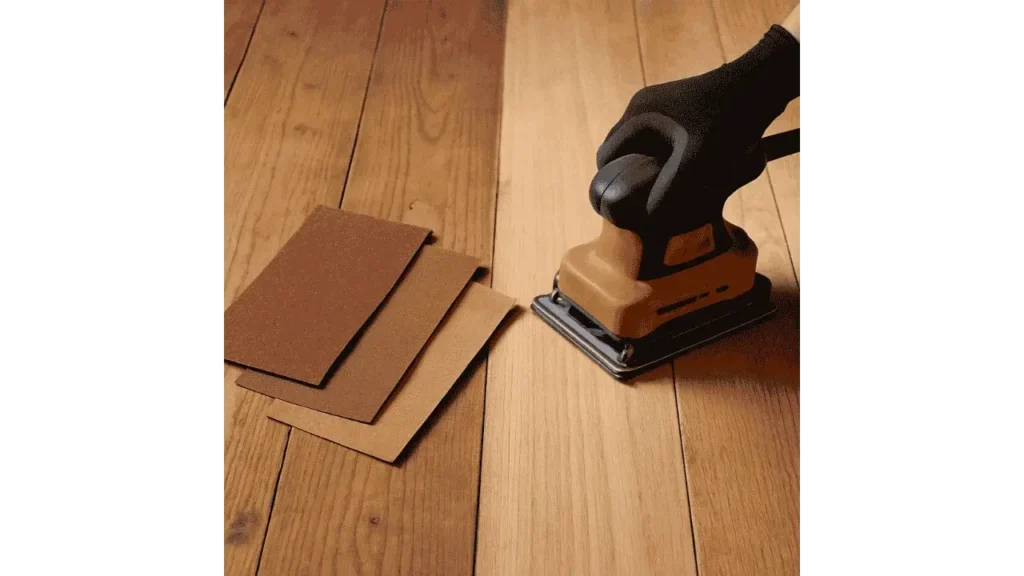Choosing the correct grit sandpaper is essential for achieving smooth, professional-looking wood floors. Sanding is a multi-step process that removes old finishes, smooths imperfections, and prepares the floor for staining or sealing. The right sandpaper grit ensures even sanding without damaging the wood. This guide will explain which sandpaper grits to use at each stage of sanding wood floors.

Understanding Sandpaper Grit:
Sandpaper grit refers to the size of the abrasive particles on the sandpaper. Lower grit numbers have larger, coarser particles that remove material quickly, while higher grit numbers have finer particles for smoothing and finishing surfaces. For wood floors, using a progression of grits is necessary for the best results.
Best Grit Sandpaper for Sanding Wood Floors:
1. Coarse Grit (36- 40 Grit) , For Initial Sanding
Start with 36 to 40-grit sandpaper for the first sanding pass. This coarse grit effectively removes old finishes, deep scratches, stains, and uneven surfaces. It’s ideal for floors that are heavily worn or have multiple layers of old finish.
2. Medium Grit (60, 80 Grit) , For Smoothing the Surface
After the initial sanding, switch to 60 or 80-grit sandpaper. This medium grit smooths out the rough surface left by the coarse grit and removes any remaining finish or scratches. It prepares the wood for the final sanding stage.
3. Fine Grit (100, 120 Grit) , For Final Sanding
Finish the sanding process with 100 to 120-grit sandpaper. This fine grit smooths the wood surface, erases minor scratches, and prepares the floor for staining or sealing. This step is essential for achieving a clean, polished look.
Learn More: How Long Should Wood Floor Sit in House Before Installing?
Special Considerations for Wood Types:
Sanding Softwoods (Pine, Fir)
Softwoods are more prone to scratches due to their softer surface. Start with 40 or 60-grit sandpaper and finish with 120-grit to gently smooth the surface without causing damage.
Sanding Hardwoods (Oak, Maple)
Hardwoods are dense and can withstand coarser sanding. Begin with 36-grit and work up to 100 or 120-grit for a sleek and refined finish.
Sanding Exotic Woods
Dense exotic woods require finer grits early in the process. Begin with a finer grit than usual to prevent surface damage and ensure a smooth, even finish.
Read More: Cost of Leveling a Wood Floor
Tips for Sanding Wood Floors:
Sand Along the Grain
Always sand in the direction of the wood grain to avoid cross-grain scratches, which can be difficult to remove.
Gradual Progression of Grits
Move step-by-step through progressively finer grits to achieve a smooth, even surface.
Replace Sandpaper Frequently
Worn sandpaper reduces efficiency. Replace sandpaper as it dulls to maintain consistent sanding quality.
Use Edge Sanders for Corners
Edge sanders are perfect for reaching corners and edges, ensuring the entire floor has a uniform finish.
Conclusion:
Selecting the right sandpaper grit is crucial for successfully sanding wood floors. Begin with 36-40 grit for heavy removal, transition to 60-80 grit for smoothing, and finish with 100-120 grit for a polished, ready-to-finish surface. Adjust your sanding approach based on the type of wood to protect your floors and achieve a flawless result. By following these guidelines, you’ll create beautiful, smooth wood floors ready for staining or sealing.
